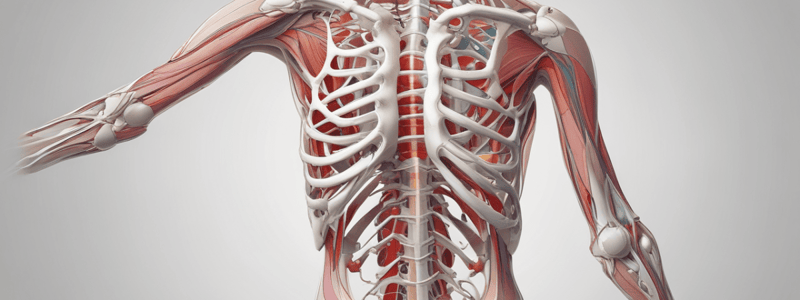Podcast
Questions and Answers
What is the primary function of bones in the musculoskeletal system?
What is the primary function of bones in the musculoskeletal system?
What type of joint allows for only a little movement, such as in the spine or ribs?
What type of joint allows for only a little movement, such as in the spine or ribs?
What is the ability of a muscle to shorten and generate pulling force?
What is the ability of a muscle to shorten and generate pulling force?
What is the plasma membrane of a muscle cell?
What is the plasma membrane of a muscle cell?
Signup and view all the answers
What is the ability of a muscle to recoil to its original resting length after being stretched?
What is the ability of a muscle to recoil to its original resting length after being stretched?
Signup and view all the answers
What is the function of synovial fluid in synovial joints?
What is the function of synovial fluid in synovial joints?
Signup and view all the answers
What are the tiny invaginations of the sarcolemma called?
What are the tiny invaginations of the sarcolemma called?
Signup and view all the answers
What is the cytoplasm of a muscle fiber called?
What is the cytoplasm of a muscle fiber called?
Signup and view all the answers
What are the main components of thin filaments?
What are the main components of thin filaments?
Signup and view all the answers
What is the function of the sarcomeres in a muscle fiber?
What is the function of the sarcomeres in a muscle fiber?
Signup and view all the answers
What is the sliding filament mechanism?
What is the sliding filament mechanism?
Signup and view all the answers
What is the role of the neuromuscular junction?
What is the role of the neuromuscular junction?
Signup and view all the answers
What is the ratio of thin filaments to thick filaments in the regions of filament overlap?
What is the ratio of thin filaments to thick filaments in the regions of filament overlap?
Signup and view all the answers
What are the small membranous sacs in the axon terminal of the motor neuron called?
What are the small membranous sacs in the axon terminal of the motor neuron called?
Signup and view all the answers
What is the function of the Z discs in a sarcomere?
What is the function of the Z discs in a sarcomere?
Signup and view all the answers
What remains the same in both relaxed and contracted muscle?
What remains the same in both relaxed and contracted muscle?
Signup and view all the answers
Study Notes
Musculoskeletal System
- The musculoskeletal system consists of bones, muscles, and joints that work together to provide support, protection, and movement to the body.
Functions of Bones
- Support of the body
- Protection of soft organs
- Movement due to attached skeletal muscles
- Storage of minerals and fats
- Blood cell formation
Joints
- Types of joints:
- Fibrous joints: connect bones without allowing any movement (e.g., bones of skull and pelvis)
- Cartilaginous joints: allow for limited movement (e.g., spine or ribs)
- Synovial joints: allow for more movement (e.g., cavities between bones filled with synovial fluid)
Properties of Muscle Tissue
- Excitability: capacity of muscle to respond to a stimulus
- Contractility: ability of a muscle to shorten and generate pulling force
- Elasticity: ability of muscle to recoil to original resting length after stretched
- Extensibility: muscle can be stretched back to its original length
Muscle Fibers
- Each skeletal muscle is a separate organ composed of hundreds to thousands of muscle fibers
- Sarcolemma: the plasma membrane of a muscle cell
- Transverse (T) tubules: tiny invaginations of the sarcolemma that tunnel in from the surface toward the center of each muscle fiber
- Sarcoplasm: the cytoplasm of a muscle fiber
Thin and Thick Filaments
- Myofibrils: the contractile organelles of skeletal muscle
- Thin filaments: composed mostly of the protein actin
- Thick filaments: composed mostly of the protein myosin
- Both are directly involved in the contractile process
Sarcomeres
- The filaments inside a myofibril do not extend the entire length of a muscle fiber
- Instead, they are arranged in compartments called sarcomeres, which are the basic functional units of a myofibril
- Z discs: narrow, plate-shaped regions of dense protein material that separate one sarcomere from the next
Sliding Filament Mechanism
- Muscle contraction is a folding process, somewhat like closing an accordion
- Skeletal muscle shortens during contraction because the thick and thin filaments slide past one another
- The model describing this process is known as the sliding filament mechanism
Neuromuscular Junction
- Region where the motor neuron stimulates the muscle fiber
- The neuromuscular junction is formed by:
- End of motor neuron axon (axon terminal)
- The motor end plate of a muscle (specific part of the sarcolemma that contains ACh receptors)
Studying That Suits You
Use AI to generate personalized quizzes and flashcards to suit your learning preferences.
Related Documents
Description
This quiz covers the general organization, functions, and parts of the musculoskeletal system, including the classification of bones by location and functions of bones.




